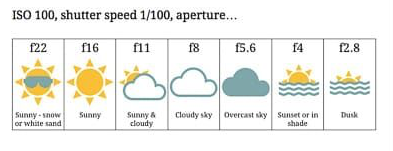When you are shooting film on older cameras it is often necessary to have some means of deciding the exposure combination, as you might have a camera with no kind of light meter. You could carry a separate light meter, but very often you can use the Sunny 16 rule to calculate the necessary settings for your exposure.
It is not known who developed this rule but it is quite convenient when not having a light meter around. Furthermore, the rule is based on incident light not on reflected light. The advantage is that black subjects will still appear black and bright objects will appear bright.
The fundamentals of the Sunny 16 rule is: On a sunny day you set the aperture to 16 and the shutter speed to the reciprocal value of the ISO for you film (or the ISO setting on digital camera) when shooting a subject in direct sun light.
As an example if using a film like Ilford FP4+ that has an ISO of 125, in bright sun light you would set your aperture to 16 and your shutter speed to 1/125 second.
For other situations see the table and the illustration below.
| Aperture | Lighting conditions | Shadow detail |
|---|---|---|
| f/22 | Snow/sand | Dark with sharp edges |
| f/16 | Sunny | Distinct |
| f/11 | Slight overcast | Soft around edges |
| f/8 | Overcast | Barely visible |
| f/5.6 | Heavy overcast | No shadows |
| f/4 | Open shade/sunset | No shadows |

If your subject is backlit you open up one stop.
I find the rule to be very easy to use once you’we gotten used to it. It gives exact rendering of all shades of grey, but it can’t take into consideration if the contrast of the scene is greater than your film can render. In that case you have to choose if your blacks are going to be featureless or your highlights are going to be blown out, and compensate accordingly.